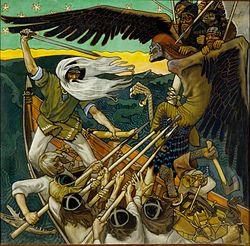
Back عصر طلایی هنر فنلاند Persian Suomen taiteen kultakausi Finnish Âge d'or de l'art finlandais French Золотой век финского искусства Russian Den finländska konstens guldålder Swedish Золота доба фінського мистецтва Ukrainian



The Golden Age of Finnish Art coincided with the national awakening of Finland, during the era of the Grand Duchy of Finland under the Russian Empire. It is believed to span an era from the late 19th Century to the early 20th Century, approximately 1880 to 1910.[1] The epic poetry form known as Kalevala, developed during the 19th Century, provided the artistic inspiration for numerous themes at the time, including in visual arts, literature, music and architecture;[2] however, the "Golden Age of Finnish Art" is generally regarded as referring to the realist and romantic nationalist painters of the time.[3] Notable figures of the time include Akseli Gallen-Kallela, Pekka Halonen, Albert Edelfelt, Jean Sibelius, Eino Leino, Helene Schjerfbeck, Emil Wikström, Eero Järnefelt and Eliel Saarinen.
Finnish art became more widely known in Europe at the Paris Exposition of 1900, where the Finnish pavilion was one of the most popular among the attendees.[4]
- ^ Salo, Maaria (21 February 2017). "Suomen taiteen kultakausi ja taiteilijan Kultakausi". Kritiikin Uutiset. Retrieved 8 July 2020.
- ^ "Kalevala - Suomen taiteen kultakausi". Suomalaisen Kirjallisuuden Seura. Archived from the original on 2016-03-05. Retrieved 2017-12-10. "Archived copy". Archived from the original on 2016-03-05. Retrieved 2017-12-11.
{{cite web}}: CS1 maint: archived copy as title (link) - ^ "Suomen Taidehistoria". Suomen Virtuaaliammattikorkeakoulu. Archived from the original on 16 July 2020. Retrieved 15 July 2020. "Archived copy". Archived from the original on 16 July 2020. Retrieved 15 July 2020.
{{cite web}}: CS1 maint: archived copy as title (link) - ^ "The Golden Age of Finnish Art". Art Museum of Estonia. Archived from the original on 2017-12-10. Retrieved 2017-12-10. "Archived copy". Archived from the original on 2017-12-10. Retrieved 2017-12-11.
{{cite web}}: CS1 maint: archived copy as title (link)